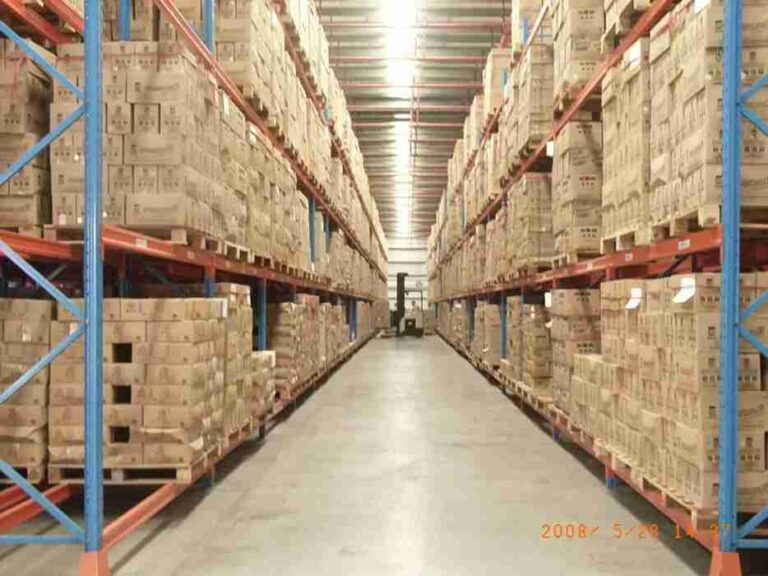📐 "First 50 Enterprise Queries Get Custom 3D Warehouse Design" Plan

Introduction: Why Double Deep Racking for Distribution Centers is a Game-Changer
In the competitive world of logistics and warehousing, maximizing storage density while maintaining operational efficiency is no longer optional—it’s a necessity. Double deep racking for distribution centers has emerged as one of the most effective high-density storage solutions, enabling businesses to double their pallet capacity without expanding their facility footprint.
This in-depth guide explores how double deep racking for distribution centers enhances warehouse productivity, reduces operational costs, and improves inventory management. Whether managing a retail distribution hub, e-commerce fulfillment center, or manufacturing storage facility, this system provides unmatched space optimization and streamlined material handling.

H1: What is Double Deep Racking for Distribution Centers?
H2: Definition and Core Functionality
Double deep racking for distribution centers is a high-density pallet storage system where pallets are stored two-deep in each row, unlike traditional selective racking, which only allows single-depth access. This configuration minimizes aisle space, increasing storage capacity by up to 50% while maintaining accessibility with specialized forklifts.
H2: How Double Deep Racking for Distribution Centers Works
- Uses narrower aisles, requiring narrow-aisle reach trucks or double-deep forklifts.
- Pallets are stored in two consecutive rows, with the second pallet placed directly behind the first.
- Operates on a first-in, last-out (FILO) system, making it ideal for high-volume distribution centers with low SKU variability.
H1: Key Benefits of Double Deep Racking for Distribution Centers
H2: 1. Dramatically Increased Storage Capacity
By reducing aisle space, double deep racking for distribution centers allows up to 50% more pallet positions compared to standard selective racking.
H2: 2. Optimized Space Utilization
- Perfect for distribution centers with limited square footage.
- Enables higher inventory turnover without expanding the warehouse.
H2: 3. Cost-Effective Warehouse Expansion Alternative
- Eliminates the need for costly facility expansions.
- Lower upfront investment than automated storage systems.
H2: 4. Enhanced Operational Efficiency
- Reduces forklift travel time with fewer aisles.
- Speeds up pallet retrieval with trained operators.
H2: 5. Flexibility with Various Pallet Sizes
- Accommodates standard (48″x40″) and custom pallet sizes.
- Adaptable for mixed-load distribution centers.
H1: When Should Distribution Centers Use Double Deep Racking?
H2: Ideal Use Cases for Double Deep Racking for Distribution Centers
✔ High-volume warehouses with consistent product lines.
✔ Retail and e-commerce fulfillment centers needing dense storage.
✔ Cold storage facilities where space optimization is critical.
✔ Manufacturing plants storing bulk raw materials.
H2: When to Avoid Double Deep Racking
✖ Operations requiring frequent access to all pallets (FIFO systems).
✖ Facilities with high SKU variability and low inventory turnover.
H1: Double Deep Racking for Distribution Centers vs. Other Storage Systems
H2: Double Deep vs. Selective Racking
| Feature | Double Deep Racking for Distribution Centers | Selective Racking |
|---|---|---|
| Storage Density | 40-50% higher | Standard |
| Accessibility | FILO system (limited rear access) | Direct access to all pallets |
| Forklift Requirements | Narrow-aisle reach trucks | Standard forklifts |
H2: Double Deep vs. Drive-In Racking
- Drive-in racking allows deeper storage but reduces selectivity.
- Double deep racking for distribution centers offers better pallet accessibility.
H2: Double Deep vs. Push-Back Racking
- Push-back racking provides dynamic storage but at a higher cost.
- Double deep racking is more economical for static inventory needs.
H1: Best Practices for Implementing Double Deep Racking for Distribution Centers
H2: 1. Conduct a Comprehensive Warehouse Analysis
- Assess inventory flow, SKU velocity, and pallet dimensions.
H2: 2. Invest in the Right Forklift Equipment
- Double-deep reach trucks or articulated forklifts are essential.
H2: 3. Optimize Slotting for Maximum Efficiency
- Place fast-moving SKUs in easily accessible lanes.
H2: 4. Train Operators for Safe and Efficient Handling
- Specialized forklift training minimizes pallet damage risks.
H2: 5. Perform Regular Maintenance & Safety Audits
- Ensure racking integrity and forklift functionality.
H1: Common Challenges & Solutions for Double Deep Racking in Distribution Centers
H2: 1. Limited Access to Rear Pallets
- Solution: Use extended-reach forklifts for deeper access.
H2: 2. Higher Forklift Skill Requirements
- Solution: Implement certified operator training programs.
H2: 3. Potential for Increased Pallet Damage
- Solution: Enforce strict pallet quality standards and proper handling techniques.
H1: Future Trends in Double Deep Racking for Distribution Centers
- Integration with warehouse automation (e.g., semi-automated retrieval systems).
- AI-driven slotting optimization for better space utilization.
H1: Conclusion – Is Double Deep Racking for Distribution Centers Right for Your Facility?
Double deep racking for distribution centers is a highly efficient storage solution for warehouses needing maximum space utilization without costly expansions. By reducing aisle space, increasing storage density, and improving operational workflows, it helps distribution centers stay competitive in fast-moving industries.
For businesses handling high-volume, low-SKU-variability inventory, double deep racking for distribution centers could be the key to unlocking greater efficiency and cost savings.
H1: Frequently Asked Questions (FAQs)
H2: 1. What type of forklift is required for double deep racking in distribution centers?
Narrow-aisle reach trucks or double-deep forklifts with extended forks are necessary.
H2: 2. Can double deep racking for distribution centers support FIFO inventory systems?
No, it’s designed for FILO (first-in, last-out). For FIFO, consider push-back or pallet flow racking.
H2: 3. How much additional storage can double deep racking provide in a distribution center?
It can increase storage capacity by 40-50% compared to selective racking.
H2: 4. Is double deep racking suitable for cold storage distribution centers?
Yes, it’s highly effective for cold storage due to space-saving advantages.
H2: 5. What is the maximum weight capacity for double deep racking in distribution centers?
Standard systems support up to 3,000 lbs per pallet, but heavy-duty configurations are available.




